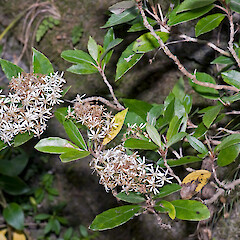Olearia cheesemanii
Common name
streamside tree daisy, Cheeseman’s tree daisy
Synonyms
Olearia nitida var. angustifolia Cheeseman, O. arborescens var. angustifolia Cheesema
Family
Asteraceae
Flora category
Vascular – Native
Endemic taxon
Yes
Endemic genus
No
Endemic family
No
Structural class
Trees & Shrubs - Dicotyledons
NVS code
The National Vegetation Survey (NVS) Databank is a physical archive and electronic databank containing records of over 94,000 vegetation survey plots - including data from over 19,000 permanent plots. NVS maintains a standard set of species code abbreviations that correspond to standard scientific plant names from the Ngä Tipu o Aotearoa - New Zealand Plants database.
OLECHE
Chromosome number
2n = 108
Current conservation status
The conservation status of all known New Zealand vascular plant taxa at the rank of species and below were reassessed in 2017 using the New Zealand Threat Classification System (NZTCS) – more information about this can be found on the NZTCS website. This report includes a statistical summary and brief notes on changes since 2012 and replaces all previous NZTCS lists for vascular plants.
Please note, threat classifications are often suggested by authors when publications fall between NZTCS assessment periods – an interim threat classification status has not been assessed by the NZTCS panel.
- Conservation status of New Zealand indigenous vascular plants, 2017 . 2018. Peter J. de Lange, Jeremy R. Rolfe, John W. Barkla, Shannel P. Courtney, Paul D. Champion, Leon R. Perrie, Sarah M. Beadel, Kerry A. Ford, Ilse Breitwieser, Ines Schönberger, Rowan Hindmarsh-Walls, Peter B. Heenan and Kate Ladley. Department of Conservation. Source: NZTCS and licensed by DOC for reuse under the Creative Commons Attribution 4.0 International licence.
2017 | At Risk – Naturally Uncommon | Qualifiers: DP, Sp
Previous conservation statuses
2012 | At Risk – Naturally Uncommon | Qualifiers: Sp
2009 | At Risk – Naturally Uncommon | Qualifiers: DP
2004 | Gradual Decline
Brief description
Bushy shrub bearing narrow pointed thin leathery dark green leaves that have an uneven edge inhabiting lowland stream margins. Twigs with a groove along the upper side. Leaves 5-9cm long by 2-3cm wide. Flowers white, in a loose cluster, body nearly 1cm long.
Distribution
Endemic to the North and South Islands. In the North Island known from the Ohinemuri River south to the Tararua Ranges. In the South Island confined to North West Nelson and the vicinity of Westport near Ngakawau.
Habitat
Rocky river gorges in or near the flood zone.
Detailed description
Shrub or small tree 0.1-1(-4) m tall. Sparingly to heavily branched depending on growing situation, bark grey, flaking in long strips. Branchlets grooved, densely covered in buff tomentum. Petioles stout, winged, finely tomentose, up to 20 mm long. Leaves (40-)50-90 x 20-30 mm, variable in shape with all types potentially present on the one individual, usually linear to narrow-lanceolate, or oblong-lanceolate, coriaceous, margins sinuate or irregularly but distinctly toothed, apex subacuminate dark green to grey-green above, undersides clad in fine, appressed, silky-hairy, white to pale buff hairs, these darkening markedly along veins and midrib. Inflorescence a lax, much-branched corymb up to 150 mm diam. Capitula 8-9 mm, phyllaries linear-lanceolate, 3-4 mm, ciliolate, ray florets 6-10(-20), narrow, white. Seed a linear finely grooved achene 2-3 mm, pappus-hairs fine, sordid-white, unequal, up to 5 mm long.
Similar taxa
Most likely to be confused with the allied O. arborescens from which it mainly differs by its narrower lanceolate leaves, usually smaller stature (in the wild at least), and habitat preferences.
Flowering
August - January
Flower colours
White, Yellow
Fruiting
November - June
Propagation technique
Easy from semi-hardwood cuttings and fresh seed. A very fast growing and attractive floriferous shrub. Tends to be short-lived. Does best in moist soils in sun or semi-shade.
Threats
Threatened by weeds such as mistflower and buddleia that invade and smother the gorge side habitat of O. cheesemanii. Surveys of northern sites indicated a population structure skewed toward senescent adults, with few juveniles and seedlings persisting due to competition from these and other smaller weed species. River conversion for hydroelectric schemes may also be a threat. Dams disrupt natural flood cycles that help create new habitat and dislodge weeds. Accurate figures on decline are not available, and the exact species distribution is unknown. It would seem this species has its strong holds in northern South Island. Further survey is likely to reveal new populations, especially in the Kaimai Ranges, Mamaku Plateau, Raukumara, Te Urewera, Ruahine and Tararua Ranges.
Etymology
olearia: Named after Johann Gottfried Olearius, a 17th-century German scholar, writer of hymns and author of Specimen Florae Hallensis
cheesemanii: Named after Thomas Frederick Cheeseman (1846 - 15 October 1923) who was a New Zealand botanist and naturalist who, in 1906, produced The Manual of the New Zealand Flora.
Where To Buy
Commonly sold by most commercial nurseries.
Attribution
Fact Sheet prepared for the NZPCN by P.J. de Lange 14 April 2006. Description adapted from Allan (1961) - supplemented with observations made from fresh specimens.
References and further reading
Allan, H.H. 1961: Flora of New Zealand. Vol. I. Government Printer, Wellington.
NZPCN Fact Sheet citation
Please cite as: de Lange, P.J. (Year at time of access): Olearia cheesemanii Fact Sheet (content continuously updated). New Zealand Plant Conservation Network. https://www.nzpcn.org.nz/flora/species/olearia-cheesemanii/ (Date website was queried)















